-
Key Takeaways
-
What Is Density Altitude?
-
Types of Altitude
-
Density Altitude Explained
- Density Altitude Is Not a Physical Altitude
- Why Is Density Altitude Important?
- What Is the Standard Temperature?
- Bringing Everything Together
-
How to Calculate Density Altitude
- How to Calculate Density Altitude Using a Flight Computer
- Calculating Density Altitude Using the Sporty’s Electronic E6B
- Calculating Density Altitude Using the ASA CX-3
- Calculating Density Altitude Using a Mechanical E6B (Whiz Wheel)
- Calculating Density Altitude Using the Density Altitude Formula
- Calculating Density Altitude Using a Density Altitude Chart
-
Conclusion
Calculating density altitude is like filing your taxes; annoying and often neglected until the last minute, but crucially important.
Why is density altitude critical to ensuring safety, what factors affect it, and how is it calculated? Today is the day that the mystery of density altitude is solved.
Key Takeaways
- Density altitude affects aircraft performance.
- Higher temperatures and altitudes increase density altitude.
- Use pressure, altitude, and temperature to calculate it.
- Calculate with a chart, formula, or flight computer.
What Is Density Altitude?

Density altitude is pressure altitude corrected for non-standard temperature. In other words, density altitude is the “effective pressure altitude” the aircraft “feels” for a given temperature.
The higher the temperature, the higher the density altitude, and the worse the aircraft performs.
Confused? No worries, let’s explain.
Types of Altitude

To fundamentally understand density altitude, you need to understand the five types of altitude used in aviation:
- Indicated altitude: the altitude read on the altimeter (regardless of altimeter setting)
- Pressure Altitude: the indicated altitude of the altimeter when it is set to 29.92
- Density Altitude: pressure altitude corrected for non-standard temperature
- Absolute altitude: the height Above Ground Level (AGL)
- True altitude: the height above Mean Sea Level (MSL)
Density Altitude Explained
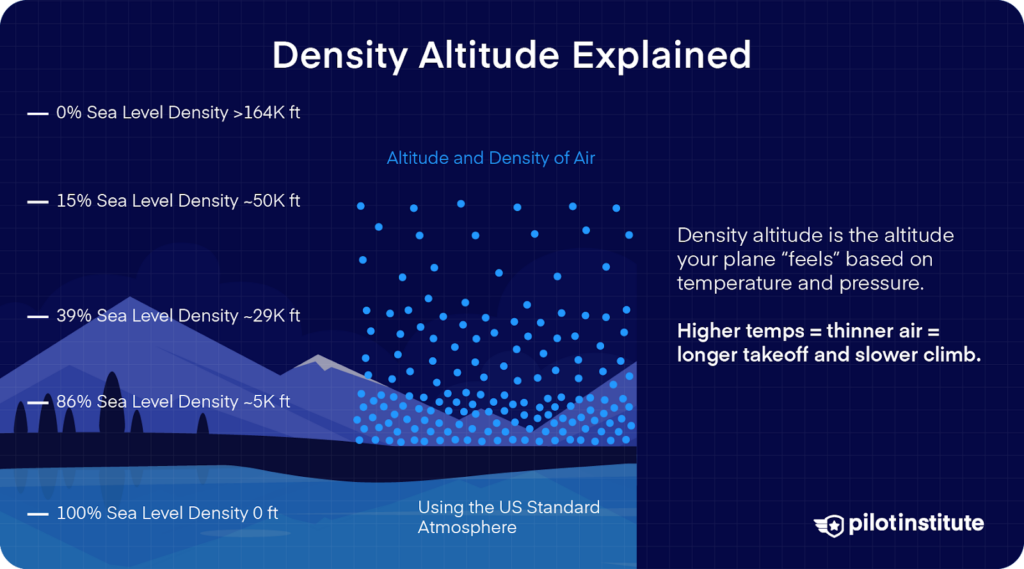
While the formal definition of density altitude is undoubtedly correct (density altitude is pressure altitude corrected for non-standard temperature), it fails to clarify that density altitude is unique because it is not a type of altitude in the traditional sense. I can hear you moaning in frustration; I promise it will all make sense.
Density Altitude Is Not a Physical Altitude
While other types of altitude describe a particular position of the aircraft or an indication of an instrument (e.g., true altitude and indicated altitude), density altitude is a performance metric. In other words, density altitude is used to describe the performance of the aircraft, similar to airspeed or rate of climb.
This revelation begs the question: What performance metric does density altitude describe, and why is it important?
Why Is Density Altitude Important?
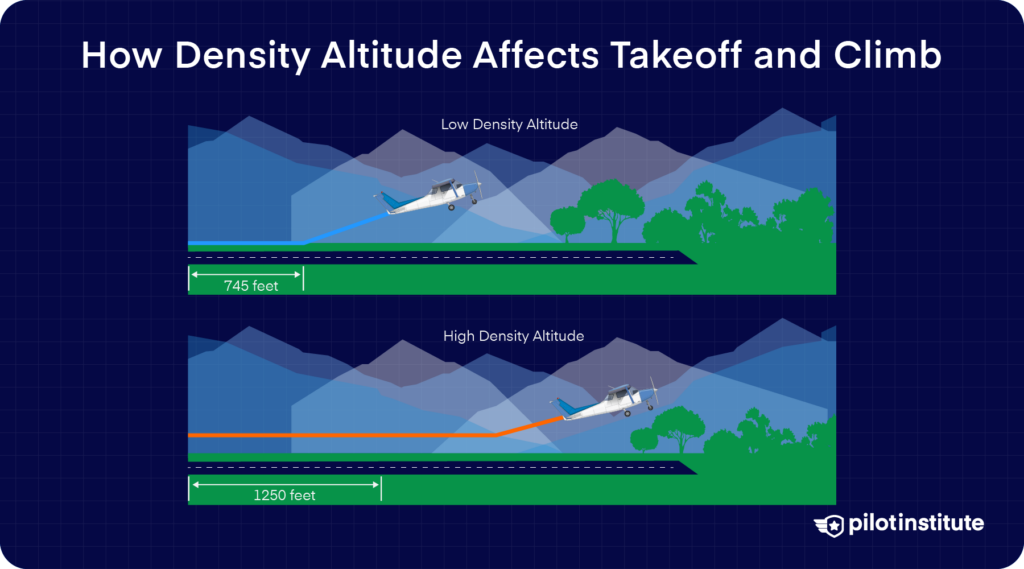
Put simply:
Higher Density Altitude = Lower Performance.
Air density is a critical factor affecting aircraft performance. Air that is less dense (lower density) causes a decrease in aircraft performance. This is due to reduced aerodynamic performance (i.e., the wings provide less lift) and reduced engine output (i.e., less horsepower).
With this in mind, the “density” in “density altitude” begins to make a lot more sense – “density” refers to air density.
Three main factors affect density altitude:
- Altitude
- At higher altitudes, air density is lower, which reduces aircraft performance.
- Temperature
- The hotter the air, the less dense it is, reducing aircraft performance.
- Humidity
- Humidity does not drastically affect density altitude, but it is a consideration. Humidity generally reduces engine performance more than aerodynamic efficiency. High humidity is not necessarily an indication of high-density altitude. Still, if humid conditions exist, it would be wise to add 10% to your takeoff distance and expect a slightly reduced rate of climb.
What Is the Standard Temperature?
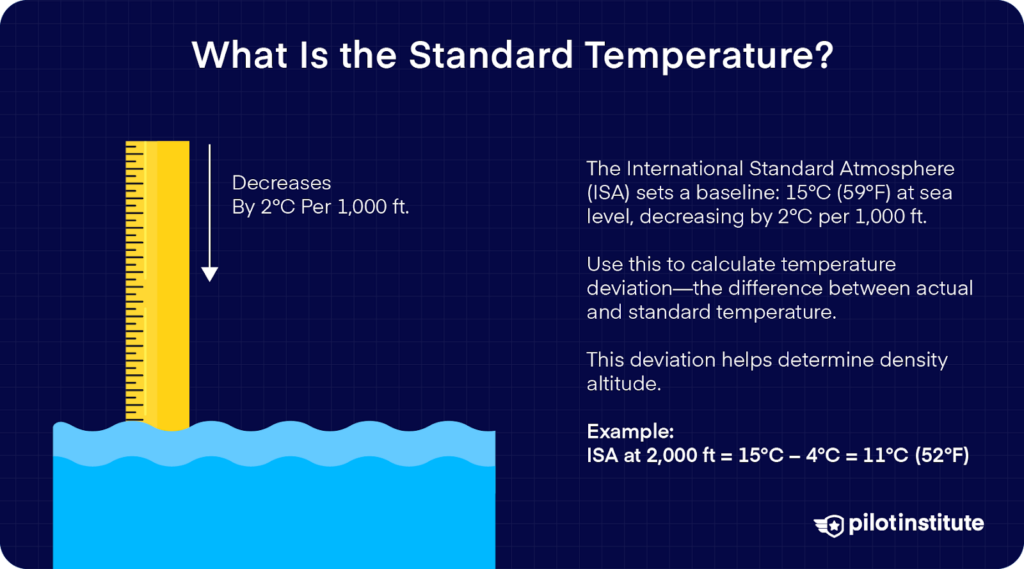
The final piece of the density altitude puzzle is the concept of standard temperature.
The International Standard Atmosphere (ISA) is a hypothetical model of the atmosphere. It is used as a reference for instrument calibration and performance calculations for values such as temperature and pressure.
The deviation of the actual atmosphere (specific temperature) for a given day and time compared to the International Standard Atmosphere (ISA) is used to determine density altitude.
Regarding temperature, the International Standard Atmosphere (ISA) uses 15°C (59°F) at Mean Sea Level (MSL) as the reference temperature, decreasing by 2°C (3.5°F) per 1,000ft.
This can then be used to determine the standard (ISA) temperature deviation, in other words, the difference between the actual atmosphere and the hypothetical ISA atmosphere.
Therefore:
- Standard Temperature = International Standard Atmosphere (ISA) Temperature.
- Standard Temperature Deviation = The difference between ISA temperature and the actual temperature.
If the actual temperature is different from the ISA temperature (for example, if the actual temperature is 26°C (80°F) at MSL instead of the ISA 15°C (59°F) at MSL), the actual temperature is known as a non-standard temperature because it does not match the hypothetical ISA temperature. The actual temperature almost always differs from ISA temperature on a given day and time.
For altitudes above MSL, minus 2°C (3.5°F) per 1,000ft from the MSL ISA temperature of 15°C (59°F) to determine the ISA temperature at that altitude.
For example, the ISA temperature at Mean Sea Level (MSL) is 15°C (59°F). What is the ISA temperature at 2,000ft? ISA assumes a temperature decrease of 2°C (3.5°F) per 1,000ft, so for 2,000ft, that would be a 4°C (7°F) decrease. Therefore, the ISA temperature at 2,000ft is 11°C (52°F).
Bringing Everything Together
All right, so far, we have established 4 things:
- Density altitude is a performance metric, not an actual altitude in the traditional sense.
- The lower the air density, the worse the aircraft performs.
- “Density” in “Density Altitude” refers to air density.
- The International Standard Atmosphere (ISA) provides a reference temperature for density altitude calculations, known as a standard (i.e., ISA) temperature.
Let’s bring it all together.
Imagine you’re flying at a pressure altitude of 2,000ft. If you climb to a pressure altitude of 10,000ft, will the aircraft’s performance be better or worse? It will be worse because of the reduced air density at 10,000ft compared to 2,000ft.
Now imagine that you’re at 2,000ft pressure altitude in standard temperature conditions (ISA). If the temperature increases at this altitude, will the aircraft’s performance be better or worse? It will be worse because of a decrease in air density due to the increase in temperature.
This deviation from standard temperature is the basis of the density altitude calculation. The standard temperature at 2,000ft is 11°C (52°F).
If the actual temperature at 2,000ft is 21°C (70°F), it is 10°C (18°F) higher than the standard temperature.
Because the actual temperature is 10°C (18°F) higher than the standard temperature, the aircraft will perform as if it is at 3,100ft. 3,100ft is therefore referred to as the density altitude.
The 3,100ft density altitude value can be determined using a flight computer, density altitude chart, or the density altitude formula. Let’s look at how to use these methods to calculate density altitude.
How to Calculate Density Altitude
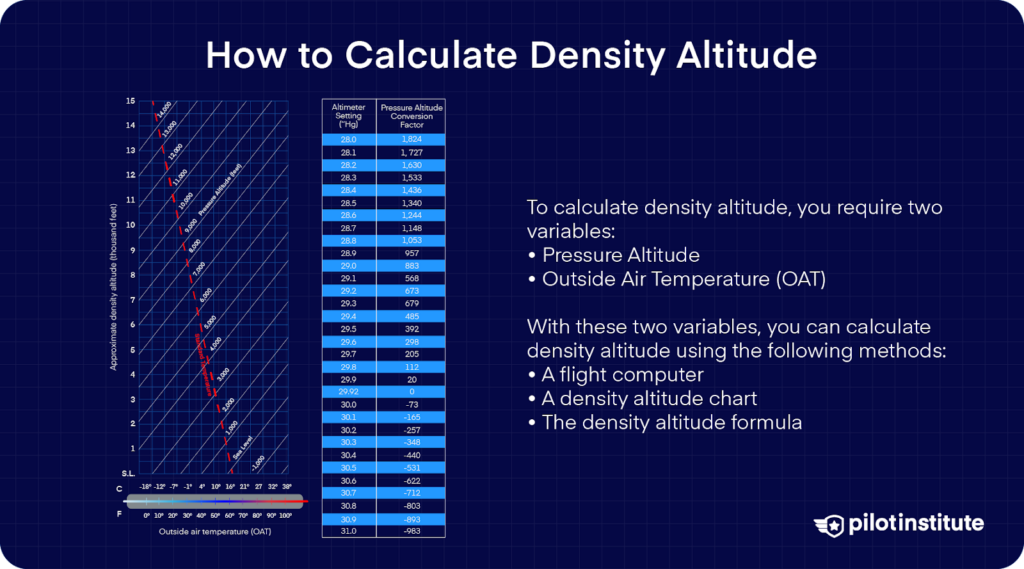
To calculate density altitude, you require two variables:
- Pressure Altitude
- Outside Air Temperature (OAT)
With these two variables, you can calculate density altitude using the following methods:
- A flight computer.
- A density altitude chart.
- The density altitude formula.
How to Calculate Density Altitude Using a Flight Computer

The easiest and most common way of calculating density altitude is by using a flight computer.
Flight computers come in three primary forms:
- A mechanical E6B, often referred to as a “whiz wheel.”
- An electronic E6B, also referred to as an “aviation calculator.”
- Software, usually an app on a phone.
The pros and cons of each are beyond the scope of this article, but the fastest and simplest way of calculating density altitude is by using an electronic E6B or an equivalent app.
The Sporty’s Electronic E6B and the ASA CX-3 are the two most popular electronic E6Bs on the market and the only two approved for Federal Aviation Administration (FAA) exams.
Calculating Density Altitude Using the Sporty’s Electronic E6B

1) To calculate density altitude using Sporty’s Electronic E6B flight computer, start by pressing the “HDG/GS/P-D/ALT” button.

2) Use the down arrow key to scroll down to the P-D/ALT menu. Press ENTER.
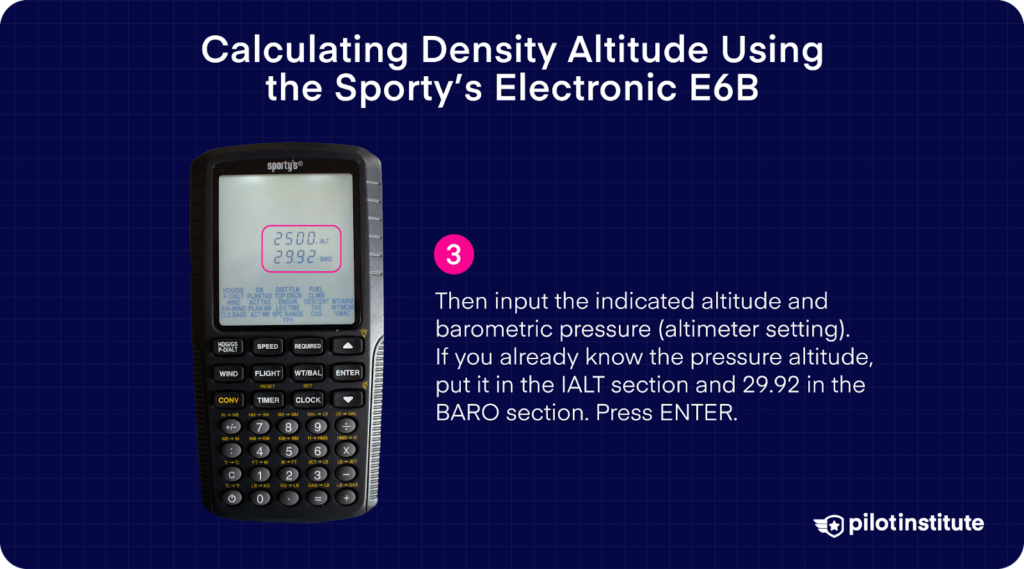
3) Then input the indicated altitude and barometric pressure (altimeter setting). If you already know the pressure altitude, put it in the IALT section and 29.92 in the BARO section. Press ENTER.

4) Input the temperature (in degrees Celsius) and press ENTER. Your density altitude will then be calculated at the bottom.

5) If you need to convert any units, scroll down to the input you want to convert and press the yellow CONV button, then press any key with the associated yellow conversion markings above it.
Calculating Density Altitude Using the ASA CX-3
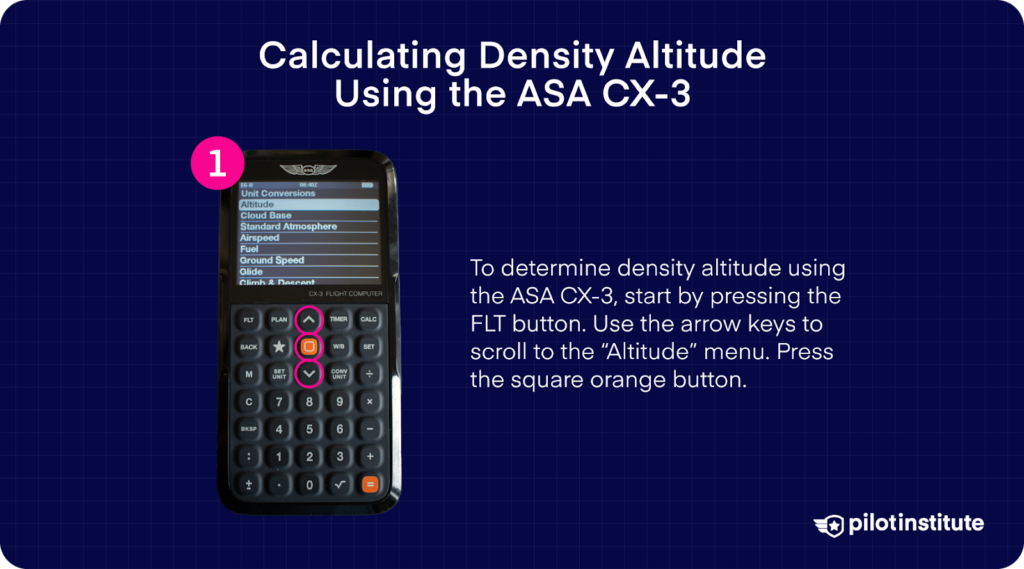
1) To determine density altitude using the ASA CX-3, start by pressing the FLT button. Use the arrow keys to scroll to the “Altitude” menu. Press the square orange button.
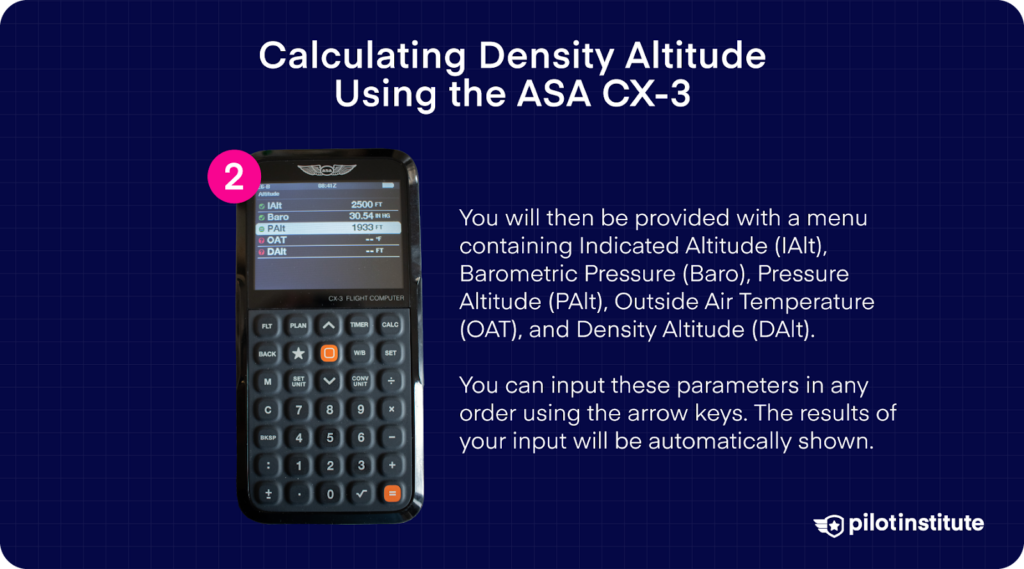
2) You will then be provided with a menu containing Indicated Altitude (IAlt), Barometric Pressure (Baro), Pressure Altitude (PAlt), Outside Air Temperature (OAT), and Density Altitude (DAlt).
You can input these parameters in any order using the arrow keys. The results of your input will be automatically shown.
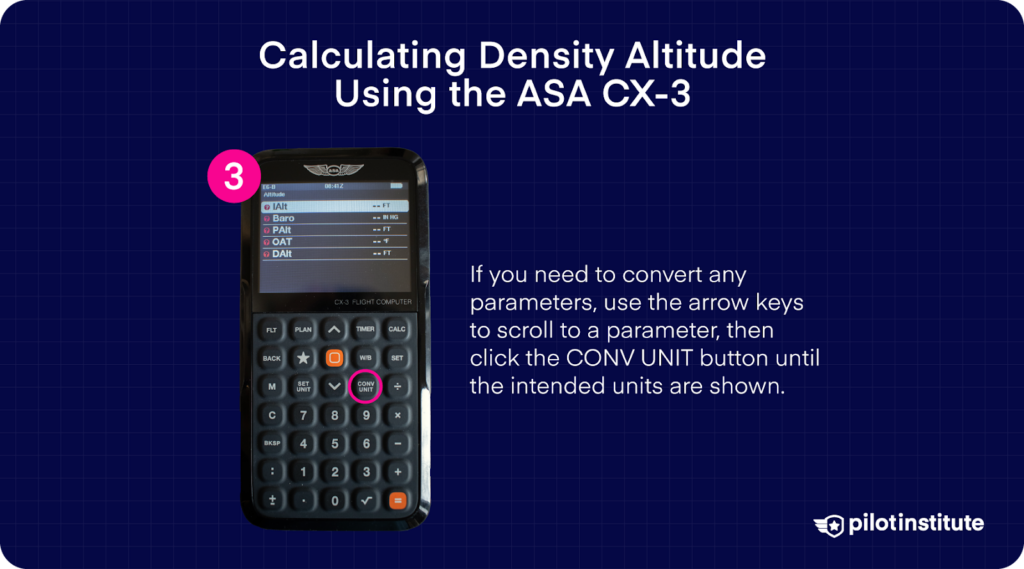
3) If you need to convert any parameters, use the arrow keys to scroll to a parameter, then click the CONV UNIT button until the intended units are shown.
Calculating Density Altitude Using a Mechanical E6B (Whiz Wheel)
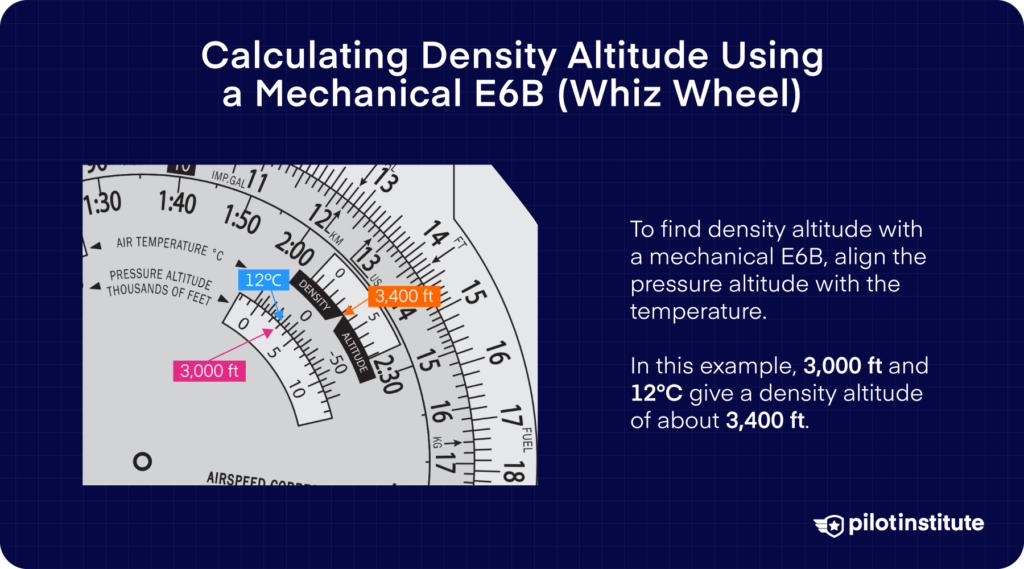
- To calculate density altitude using a mechanical E6B (Whiz Wheel), line up the pressure altitude window with the temperature scale above.
- You will then be able to read the density altitude from the density altitude window above.
- In this example, the pressure altitude is 3,000ft, and the temperature is 12°C. This provides us with a density altitude of roughly 3,400ft.
Calculating Density Altitude Using the Density Altitude Formula
You can calculate density altitude using the following density altitude formula:
- Density Altitude in Feet = Pressure Altitude in Feet + (120 x (OAT°C – ISA Temperature °C))
Here is a shortened version of the formula, where:
DA = Density Altitude (ft),
PA = Pressure Altitude (ft),
OAT = Outside Air Temperature (Celsius),
ISA = Standard Temperature (Celsius)
- DA = PA + (120 x (OAT – ISA))
For example, if the temperature at 3,000ft pressure altitude is 12°C, the density altitude formula will be:
- DA = 3,000 + (120 x (12 – 9)) Note: 9 is the ISA temp (°C) for 3,000ft
Therefore, the density altitude will be 3,360ft.
Calculating Density Altitude Using a Density Altitude Chart
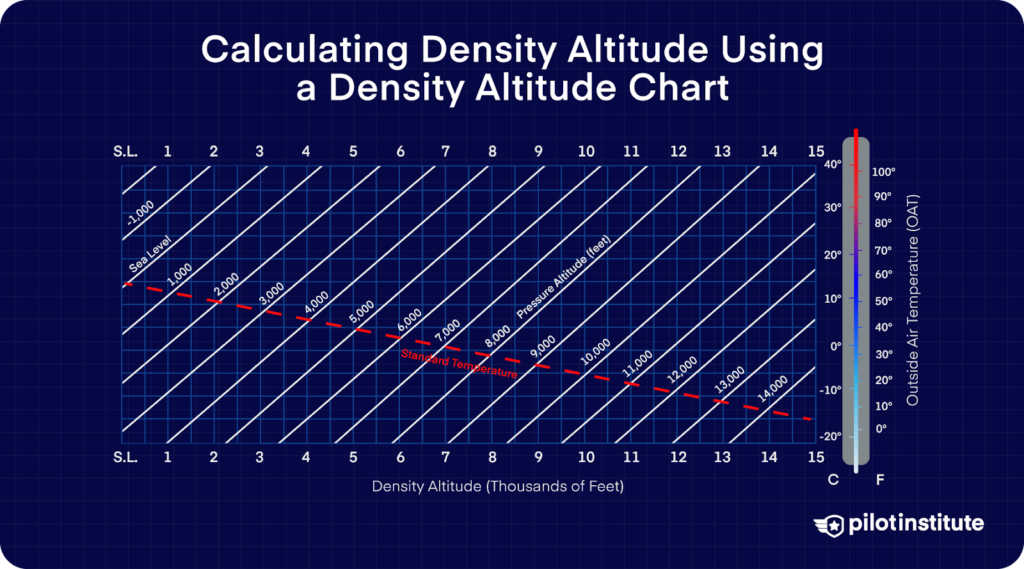
Density altitude charts can be found in most Pilot Operating Handbooks (POHs).
Let’s look at how to calculate density altitude using the most common version of a density altitude chart.
In this example, the pressure altitude will be 3,000ft, and the Outside Air Temperature (OAT) will be 12°C.
1) Start by plotting the OAT by drawing a line vertically from the bottom of the chart at the corresponding OAT up to the diagonal line representing the pressure altitude.
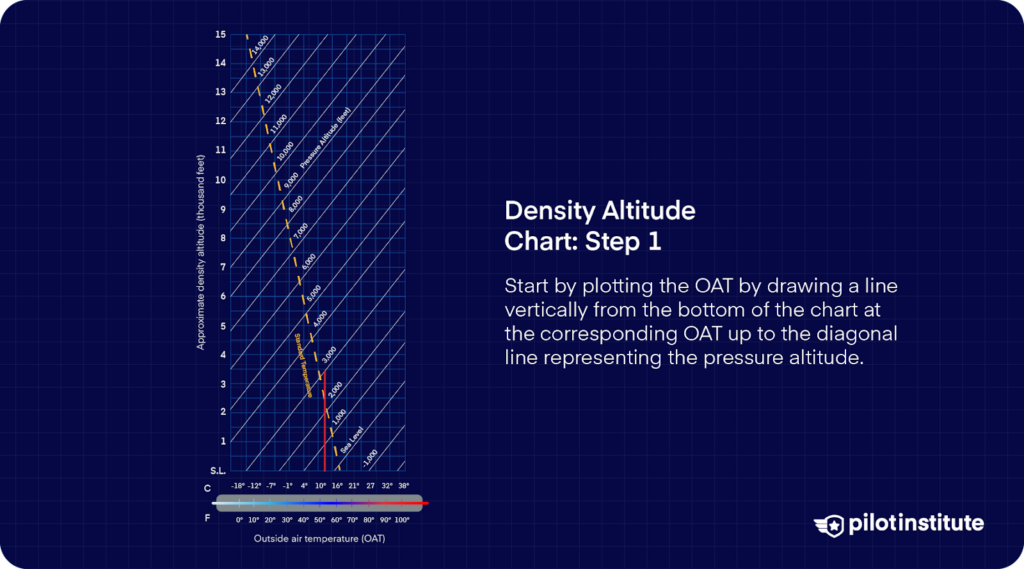
2) Now draw a horizontal line to the left until you reach the density altitude indication. In this example, the density altitude is roughly 3,400ft – found on the left axis (Y-axis).
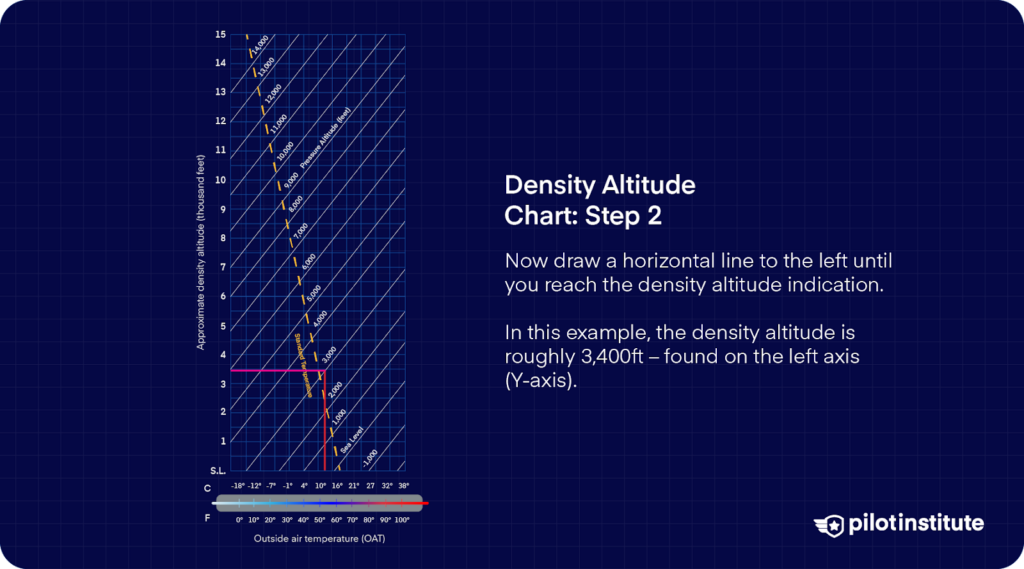
3) If you need to convert indicated altitude to pressure altitude, you can use the pressure altitude conversion table by adding or subtracting the conversion factor for a particular altimeter setting from your indicated altitude.
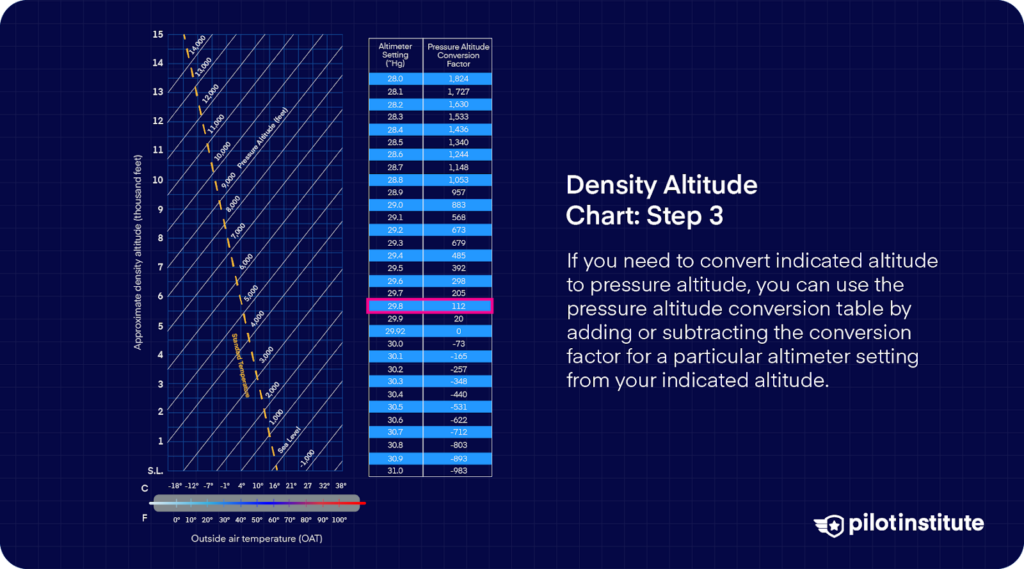
For example, if your indicated altitude was 2,500ft with an altimeter setting of 29.80, you would add 112ft to 2,500ft (112ft is found on the chart). Your pressure altitude would therefore be 2,612ft.
Conclusion
Although density altitude is not a sexy topic of conversation, it is an important concept to understand. Many who have tried to ignore or disregard it have not survived to tell the tale.
With the information you have received from this article, you can move forward with your training or continue with your adventures knowing that you have a fundamental understanding of how to calculate density altitude. Stay safe!



